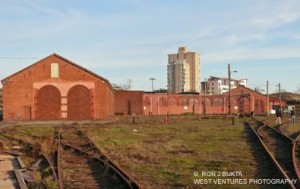 The Johnson Street Bridge spans the gap between downtown Victoria and the Victoria West and defines the entrance to the Upper Harbor.
The Johnson Street Bridge spans the gap between downtown Victoria and the Victoria West and defines the entrance to the Upper Harbor.
It has, for years, been the major land link to Esquimalt and the naval base there.
The bridge that we see in the 1907 video was replaced in 1920 by the current bascule type bridge. The Strauss Bascule Company Limited who held the patents on the design prepared the design for the bascule spans and the operating machinery. Joseph Strauss later went on to design the Golden Gate Bridge in San Francisco. The superstructure of the bridge was fabricated in Walkerville, Ontario and contains 100 tons of steel. The City of Victoria Engineering Department built the sub-structure of the bridge. It required 10,000 cubic yards of concrete.
The main opening span is 148 feet in length and when in the open position is balanced over a 45-foot fixed span. It was opened in 1924, having cost $918,00 to construct.
Steaming over the bridge in the video is one of the Esquimalt and Nanaimo Railway locomotives. The history of the railroad begins when British Columbia joined confederation in 1871. Under the terms of union, the federal government was required to start construction of a railroad joining British Columbia to the rest of Canada. In return, the province of B. C. was to grant a band of public land of up to 32 km (20 miles) in width along either side of the railway line to the federal government for it to use in furtherance of the construction of the railway.
In 1873, Prime Minister of Canada Sir John A. Macdonald had stated that Esquimalt, British Columbia, the site of a naval base, would be the terminus of the “Pacific Railway”. However, both the federal government and the Canadian Pacific Railway placed a low priority on construction of such a railway, as it had low traffic potential and would duplicate an existing steamer service. Although construction began on the section between Yale and Kamloops in 1879, nothing happened on Vancouver Island despite personal intervention by prominent politicians.
Robert Dunsmuir was interested in taking on the railway project and in the coal reserves a railway land grant would provide. He went to Ottawa in 1882 and made his case. Originally the government chose the Vancouver Land and Railway Company controlled by Lewis M. Clement of San Francisco for the job. When Clement and his company failed to come up with the necessary funds, the government quickly moved to accept Dunsmuir’s terms.
In 1883, the British Columbia provincial government signed a contract with Dunsmuir to build a railway between Esquimalt and Nanaimo in exchange for the same grant of land that Clement had negotiated, amounting to 800,000 acres (3,200 km�) plus a cash grant of $750,000 from the federal government. That amount of land was almost 20% of the entire island and included all known coal deposits. Shortly afterwards, Dunsmuir and three partners (Charles Crocker, Collis P. Huntington and Leland Stanford of California) incorporated the Esquimalt & Nanaimo Railway with Dunsmuir president and owner of one half of the shares.
Construction of the railway took three and a half years. On August 13, 1886, the last spike was driven at Cliffside, about 40 km (25 miles) north of Victoria. The spike was gold, and the hammer was silver.
Prime Minister Macdonald drove the last spike, during his only visit to British Columbia. The railway was extended to Dunsmuir’s mine at Wellington in 1887, and into Victoria in 1888. It was extended west to Port Alberni in 1911, west to Lake Cowichan in 1912, and north to Courtenay in 1914.
The E. &N. Railway was originally to have been built all the way to Campbell River, but that plan fell through due to the outbreak of World War I. Between 1905 and 1999, the E. & N. Railway was owned and operated by the Canadian Pacific Railway. VIA Rail took over operation of C. P. R.’s passenger train service (called The Malahat) in 1978 while C. P. R. demarketed its freight operation, claiming that freight traffic was declining. In 1996, the C. P. R. reorganized the E. & N. as an “internal short line” named E. &N. Railfreight while the railbarge operations were sold to Seaspan Intermodal.
In early 1999, shortline operator RailAmerica purchased the route from Nanaimo to Port Alberni, and leased the balance of the line. This RailAmerica subsidiary was named E. and N. Railway Company (1998) Ltd. and used the reporting mark ENR (the reporting mark EN was still owned by CPR), thus maintaining the historic name associations for the Vancouver Island line.
_______________________________________________________________________
This Hallmark Heritage Society project was funded by the HBC Foundation and the BC150-Heritage Legacy Fund
Project manager and researcher: Helen Edwards
Principal Photography & Consultant: Ron Bukta, West Ventures Photography
